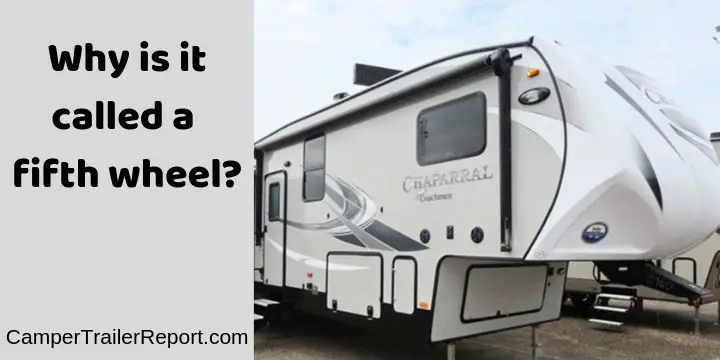
Why is it called a fifth wheel?
There is a lot of jargon as to why it is called a fifth wheel in the RV and travel trailer world. This is one term that RVers have come across multiple times but do not clearly understand what it means. Generally, the fifth wheel is a term used to describe a towable RV or travel trailer with a hitch that requires a large pickup truck for towing.
The fifth wheel is a U-shaped hitch coupling that connects it to the towing pickup truck. The fifth wheel is the point where the trailer connects to the tow vehicle, and it acts as a point for the trailer to connect its weight. The trailer’s king ping locks into the U-shaped hitch allowing the driver to pull the trailer without too much sway.
What is the difference between the 5th wheel and gooseneck?
Both the gooseneck hitch and the fifth wheel are designed to be used in a pickup truck. The difference between the two is that a gooseneck hitch uses a mounted or welded ball and coupler On the other hand; the fifth wheel uses a pin receiver and a kingpin to connect to the towing vehicle. Using the gooseneck requires one to engage the ball on the hitch to a coupler on the trailer. The fifth wheel has a kingpin funnel that engages with the kingpin on the trailer.
> You may also like:45 RV Accessory Must-Haves for Your Travel Trailer<<
What do you need to pull a 5th wheel?
a) Pickup Truck
The first thing you need to pull the fifth wheel is a pickup truck preferably a three-quarter ton truck. While getting a half-ton pickup could be an option, it might not be advisable as it might not deliver the power requirements needed to tow the trailer.
The GVWR (Gross Vehicle Weight Rating) of the pickup truck should exceed the weight of the truck and trailer by 10%. The bed length of the truck should be eight-foot, which is always best when pulling a fifth wheel trailer.
b) Time to Install
If your pickup truck meets the above standards, match the truck and the trailer for the fifth wheel installation process. It is advisable to buy your hitch from a reliable manufacturer as it comes with preexisting holes to accept your fifth-wheel. Ensure you have strong anchor points and a set of brackets that hook up to the pickup for an extra anchor. When the fifth wheel is hooked up the jaws close around the trailer’s kingpin.
Is a gooseneck better than a fifth wheel?
The fifth wheel is better when compared to the gooseneck. The fifth wheel is designed to balance the tow weight distribution of the trailer to avoid too much swaying of the trailer being towed. The fifth wheel offers a smoother ride and helps dampen the road shock from the trailer. A gooseneck hitch is mostly suitable for industrial trailers.
Does a 5th wheel tow better?
Fifth wheel tow better than other conventional towing because the equal distribution of trailer weight ensures that the swaying is reduced. Fifth wheels don’t sway because much of the weight is centered between the pickup truck and the fifth wheel axles. Another benefit of using the fifth wheel is that it helps to dampen the road shock from the trailer, meaning it is much safer to tow than other towing methods.
Video Overview: 5th Wheel towing – Is your truck big enough?
https://www.youtube.com/watch?v=_oW9WTNTWf8
You may also like: 25 Best National Parks in the USA <<
Related Questions:
Why is it called a Fifth Wheel?
In the field of campers, a fifth wheel refers to a given type of RV that gives the user similar benefits as those of a larger model without necessarily being a full brown house on wheels.
Those fifth wheels were invented in the 1980s for horse-drawn carriages. At that time, the inventors placed the horizontal wheel on the cargo frame, which gave an allowance for the axle at the front to pivot itself, thus providing viable maneuverability and stability at the same time.
This invention was further developed in the early 1900 for motor vehicles, with the name being carried on. They have developed on and on to become one of the perfect fits for towing vehicles, especially for camping lovers.
What is the best truck to pull a fifth wheel?
The best truck to tow a fifth is chosen based on several factors such as
i. Reliability.
ii. It’s towing capacity.
iii. Payload capacity.
The payload capacity will determine the amount of weight your truck will hold on its frame and suspension.
iv. Its bed length.
It’s crucial to lessen the damage to your fifth wheel since the shorter the bed length, the smaller the turning radius.
Thus whether you’re a brand loyalist or not, you will never go wrong with the Dodge Ram 3500. It’s first class. These trucks have earned their reputation in the fifth wheel towing market for checking off boxes on all of the above factors, in addition to better quality, luxury options, and craftsmanship.
Considerably the Ram 3500 has an outrageous 7680 pounds in payload capacity, can tow between 1800 to 3700 pounds, and also contains supporting hardware for attaching your fifth wheel.
Video Overview: 2021 Ram 3500. Owner first impression. 420hp 1075tq
Are Fifth Wheels safe or not?
Similar to numerous towing setups, the fifth wheels have safety concerns, with the most common being dropping the trailer. This often happens since people forget to latch the coupling pin after hooking the trailer.
Therefore whenever the truck starts moving, the trailer becomes free and thus falls onto the truck’s bed. Thus having and ensuring simple safety systems for preventing coupling such as the kingpin is in place before moving will greatly enhance your safety.
Do fifth wheels sway?
Typically the fifth wheels are not supposed to sway. Still, whenever the hitch is not attached properly, your fifth wheel is more deemed to fishtail due to factors like speeding, bad hitch weight distribution, improper towing vehicle, and the wind speed.
Therefore, if you want to prevent the above from happening, you’re required to check your vehicle’s towing capabilities, install a sway bar, and ensure your hitch is in place before starting your vehicle.
Gooseneck Hitch vs. Ball Hitch, what is the difference?
The main difference between the Gooseneck hitch and the ball hitch is based on how they are attached to a vehicle. Whereas the gooseneck hitch has a long neck that reaches over the back of the slides and tailgate while sliding over to the bed of the truck, a Ball hitch is fitted over by a couple (with a similar size and equal to the ball hitch’s weight capacity) which pivots on the ball hitch and then bolted to the end of your trailer frame.


